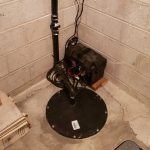Keeping Your Home Dry Safe Basement Waterproofing Solutions
The basement is an essential part of many homes, serving as storage, an extra living space, or even a retreat from the hustle and bustle of everyday life. However, it’s also one of the most vulnerable areas in your home when it comes to water damage. To protect your property and investment, it’s crucial to understand basement waterproofing solutions. In this article, we will explore the various methods and technologies available to keep your basement dry and your home safe.
The Importance of Basement Waterproofing
Before delving into specific solutions, let’s examine why basement waterproofing is essential for your home:
- Prevents Structural Damage: Water intrusion can weaken your basement’s foundation and structure over time, leading to costly repairs.
- Stops Mold and Mildew: A damp basement provides the ideal breeding ground for mold and mildew, which can affect your indoor air quality and health.
- Protects Valuables: Basements often house valuable items and family heirlooms. Waterproofing ensures these possessions remain safe and dry.
- Expands Living Space: A dry basement can be transformed into a comfortable living area, increasing the usable square footage of your home.
- Preserve Home Value: A waterproofed basement adds value to your property and makes it more attractive to potential buyers.
Basement Waterproofing Solutions
Now, let’s explore some basement waterproofing solutions that can safeguard your home:
Exterior Waterproofing
Exterior waterproofing is a comprehensive approach that involves protecting the outside of your foundation walls. Here are the key components:
- Excavation: The soil around your foundation is excavated to access the exterior walls.
- Waterproof Membrane: A waterproof membrane or coating is applied to the foundation walls to create a barrier against moisture.
- Drainage Systems: French drains or exterior footing drains are installed to divert groundwater away from the foundation.
Exterior waterproofing is highly effective but can be invasive and costly due to the excavation work involved. It’s a suitable option when building a new home or during extensive renovations.
Interior Waterproofing
Interior waterproofing focuses on managing water that has already entered your basement. This approach is often more cost-effective and less disruptive:
- Interior Drainage Systems: These include perimeter drains and sump pumps, which collect and pump out water that enters the basement.
- Vapor Barriers: Installing vapor barriers on the interior walls helps prevent moisture from penetrating.
- Epoxy Injection: This method seals cracks in the foundation walls from the inside, halting water intrusion.
Interior waterproofing is a popular choice for existing homes because it doesn’t require excavation and landscaping work.
Sealants and Coatings
Sealants and coatings are versatile solutions used both inside and outside the basement:
- Epoxy: Epoxy coatings are applied to cracks and joints to create a watertight seal.
- Polyurethane: This flexible and durable material is often used for crack injection and surface sealing.
- Cementitious Coatings: These coatings bond with the concrete surface, forming a protective barrier against moisture.
Sealants and coatings are practical for minor repairs and as a preventive measure against future water intrusion.
Grading and Drainage Improvements
Ensuring proper yard grading and maintaining functional gutters and downspouts can help prevent water from pooling near your foundation:
- Grading: Adjusting the slope of your yard to direct water away from your home can be a simple yet effective solution.
- Gutters and Downspouts: Ensure they are clean and functioning correctly to prevent rainwater overflow.
Window Well Covers
Basement windows located below ground level are prone to water intrusion. Installing window well covers can prevent rainwater from entering through these openings while allowing natural light into your basement.
Dehumidification Systems
In addition to waterproofing, consider installing a dehumidification system in your basement. These systems help maintain optimal humidity levels, reducing the risk of mold growth and improving overall air quality.
Basement waterproofing is a crucial investment in the long-term health and safety of your home. Whether you choose exterior or interior solutions, sealants and coatings, grading and drainage improvements, or window well covers, addressing water intrusion promptly is essential. Keep in mind that the specific solution you need may depend on factors such as the severity of the issue, your budget, and your home’s age and construction.
Don’t let a wet basement undermine your home’s structural integrity or compromise your family’s health. By taking proactive steps to waterproof your basement, you can enjoy a dry, safe, and comfortable living space while protecting your home’s value and longevity.




























